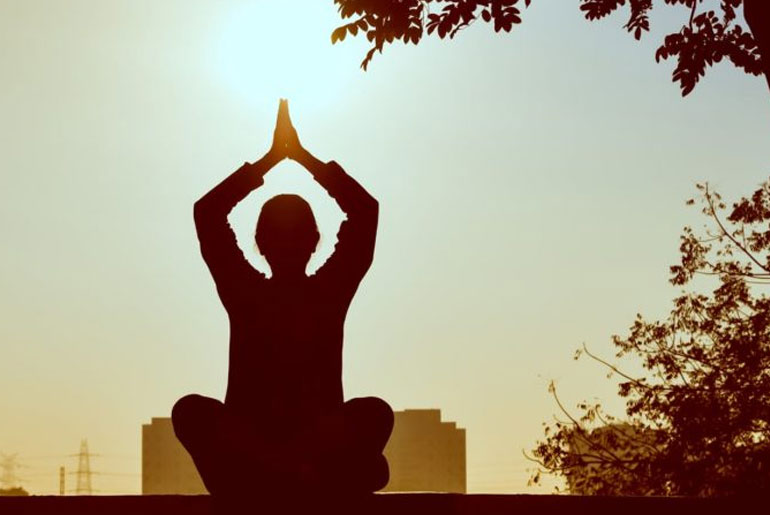In today’s fast-paced world, finding moments of peace and calm can indeed feel like a luxury. However, meditation offers a pathway to tranquility and serenity, even in just a few minutes.
Meditation, as defined by The Yoga Institute, is a practice that involves training the mind and body to achieve a state of calmness and awareness. It’s a process of focusing your attention and quieting the constant chatter in your mind.
For beginners, simple techniques such as focusing on the breath can be incredibly effective. By directing attention to the inhalation and exhalation process, individuals can begin to cultivate a sense of mindfulness. When the mind inevitably wanders, gently guiding it back to the breath is key. With consistent practice, this ability to focus improves, allowing for longer and deeper meditation sessions.
The benefits of meditation are profound. Even brief moments of practice can lead to stress reduction, increased mindfulness, and an overall improvement in well-being. As individuals progress on their meditation journey, they may discover new techniques and approaches that resonate with them, further deepening their practice and enriching their lives.
1. Equal Breathing:
Equal Breathing, also known as Yogendra Pranayama – I, is a foundational technique in yoga and meditation with profound benefits that extend beyond the mat. This simple yet powerful practice involves focusing on inhalations and exhalations of equal length, fostering calmness and concentration by anchoring attention to the breath.
Starting Position:
- Stand or sit erect in any meditative posture, with shoulders relaxed and hands by the sides.
- Maintain an erect spine and, if standing, keep feet apart while keeping the abdomen in its normal contour. Close your eyes, but if in a standing position, keep them open.
Sequence of Steps:
- Inhale slowly and continuously, ensuring a relaxed manner and a count that feels comfortable to you.
- As soon as the inhalation is complete, begin exhaling slowly, maintaining the same count as during inhalation. The goal is to equalize the duration of inhalation and exhalation.
- Concentrate on the gentle, uninterrupted flow of breath. Remain aware of all the respiratory muscles involved, starting with the diaphragm, intercostals, and clavicular muscles.
Equal Breathing serves as a potent tool for cultivating inner peace and enhancing focus. By synchronizing the breath with a consistent count, practitioners can create a sense of harmony within the body and mind. This technique can be practiced anywhere, making it accessible for individuals seeking moments of tranquility amidst their busy lives. Whether you’re new to meditation or a seasoned practitioner, Equal Breathing offers a simple yet effective method for tapping into the calming power of the breath.
2. Nispand Bhav:
Nispand Bhav, or the state of absence of movement, is a technique developed by Shri Yogendraji, the founder of the Yoga Institute, aimed at training the mind to achieve a stillness that can lead to greater mental clarity and resilience. This practice facilitates the development of a ‘bystander’ or ‘witness-like’ attitude towards life, enabling practitioners to navigate challenges with greater ease while maintaining inner balance.
Starting Position:
- Lean against a wall, allowing the head and shoulders to rest, while stretching the legs in front.
- Maintain a comfortable distance of 2-3 feet between the legs.
- Place the hands gently on the upper thighs with palms facing upwards, and close the eyes. Alternatively, if sitting on the floor is not feasible, use a firm chair. Emphasis should be on comfort rather than posture to minimize distractions.
Sequence of Steps:
- Begin by observing the breath for a few minutes, allowing the mind to settle.
- Gently shift your attention to a continuous yet faint sound.
- Passively listen to this sound without associating it with any particular object or thought.
- Maintain this posture and state of mind for approximately 15 minutes. If the mind begins to wander, gently guide it back to the sound.
- Conclude the practice by cupping the palms and placing them over the eyes. Blink gently within the cupped palms before opening the eyes.
Nispand Bhav encourages practitioners to detach from the fluctuations of the mind and cultivate a sense of inner peace and stability. It emphasizes the importance of remaining present and observant without becoming entangled in the thoughts and emotions that arise. By incorporating this practice into your routine, you can develop a balanced perspective and approach to life’s challenges, ultimately fostering a greater sense of well-being and contentment.
3. The Reverse Counting:
The Reverse Counting meditation technique offers a simple yet effective way to enhance focus and concentration while promoting a sense of inner calm. Here’s how to practice it:
Starting Position:
- Sit comfortably in any meditative posture of your choice, such as Sukhasana (Easy Pose), Padmasana (Lotus Pose), or Vajrasana (Thunderbolt Pose).
Sequence of Steps:
- Once you are settled in your chosen posture, sit absolutely still and begin counting backwards from 30 to 0 in your mind.
- Maintain your focus solely on the counting, allowing each number to be a point of concentration.
- If you happen to lose count at any point, simply return to the last number you remember and continue counting backwards from there.
- Continue this process until you successfully count down from 30 to 0 without any interruptions.
- After completing the countdown, gently cup your palms and place them over your closed eyes.
- Blink gently within the cupped palms before slowly opening your eyes.
The Reverse Counting meditation technique trains the mind to stay present and focused, helping to quiet distractions and promote mental clarity. By regularly practicing this exercise, you can strengthen your ability to concentrate and cultivate a greater sense of inner peace and tranquility.
4. Trataka:
Trataka, a kriya with multiple benefits, is traditionally practiced by yogis to not only improve eye health but also enhance concentration. Here’s how to perform it:
Eye Care:
- While splashing the eyes with water is refreshing, for Trataka, it’s recommended to wash the eyes with room temperature drinking water. Take water in one palm and dip one eye into it for a few seconds, blinking a couple of times while in the water. Repeat the process with the other eye.
Starting Position:
- Sit comfortably in any meditative posture with the head and body erect. You can also perform Trataka while seated on a chair if that’s more comfortable for you.
Sequence of Steps:
- Light a candle and place it 16 to 20 inches away from you, ensuring that the tip of the flame is just below eye level. If using an object other than a candle, maintain a similar distance. Focus your attention on a specific point of the object, making it as small as possible in your field of vision.
- Ensure there is no draft of air to keep the flame steady.
- Gaze steadily at the chosen point (tip of the flame or wick, or a specific point within the object) until tears start flowing from your eyes or until your eyes begin to feel weary. Avoid overstraining your eyes; blinking is a protective mechanism, so allow yourself to blink naturally.
- After gazing, close your eyes and visualize the object or its image within. Focus on visualizing it at the center of your forehead (bhrumadhya) until the image begins to fade.
- Gently rub your palms together to create some warmth, then place the base of your palms over your closed eyes. Hold this position for 5 to 10 seconds. This practice, known as palming, helps relax the eyes after the intense focus of Trataka.
By practicing Trataka regularly, you can not only improve your eye health but also enhance your concentration and mental focus. It’s a powerful technique that can bring clarity and calmness to the mind while promoting overall well-being.
5. Metta meditation:
Metta meditation, also known as loving-kindness meditation, is a profound practice deeply rooted in Buddhist traditions. It serves to cultivate feelings of kindness and compassion, extending not only towards others but also towards oneself.
Starting Position:
- Sit comfortably in Sukhasana (Easy Pose), Vajrasana (Thunderbolt Pose), or any other meditative posture of your choice.
- Close your eyes to turn your focus inward and prepare for the meditation.
Sequence of Steps:
- Generate Kindness Within: Begin by generating feelings of kindness and compassion within yourself. Cultivate a sense of loving-kindness towards yourself, acknowledging your own worthiness of love and compassion. Focus on your positive qualities and virtues, rather than dwelling on any perceived shortcomings.
2. Progressive Development: Proceed to extend loving-kindness towards others in a progressive manner. Here’s a typical sequence:
- Self: Start by directing loving-kindness towards yourself. Offer yourself words of kindness and compassion, recognizing your inherent value and worthiness of love.
- A Loved One: Extend loving-kindness towards someone you love deeply. Visualize them and wish them well-being, happiness, and peace.
- A Neutral Person: Shift your focus to someone you may not have strong feelings towards, perhaps a casual acquaintance or stranger. Offer them loving-kindness, wishing them happiness and freedom from suffering.
- A Difficult Person: Extend loving-kindness towards someone with whom you may have conflicts or difficulties. This can be challenging but offers an opportunity for healing and reconciliation. Wish them well-being and peace, regardless of past grievances.
- Other Beings: Expand your circle of loving-kindness to include other living beings, such as animals and creatures.
- The Entire Universe: Finally, extend loving-kindness towards all beings in the universe. Visualize the entire world bathed in loving-kindness, wishing for the happiness and well-being of all.
Throughout the practice, maintain an objective and non-judgmental attitude. Focus on cultivating genuine feelings of kindness and compassion, letting go of any negativity or resistance. Metta meditation is a powerful tool for nurturing a kind and compassionate heart, fostering inner peace and harmony, and promoting positive connections with others and the world around us.
Disclaimer:
The information contained in this article is for educational and informational purposes only and is not intended as a health advice. We would ask you to consult a qualified professional or medical expert to gain additional knowledge before you choose to consume any product or perform any exercise.








